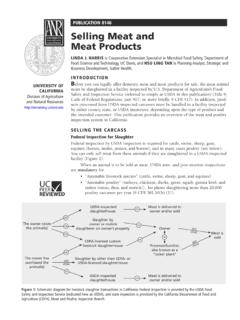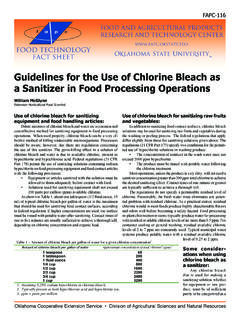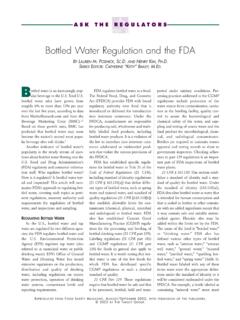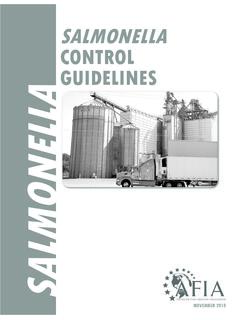Transcription of Garlic: Safe Methods to Store, Preserve, and Enjoy
1 ANR Publication 8568 | October 2016 J. HARRIS, Specialist in Cooperative Extension, Microbial Food Safety, Department of Food Science and Technology, University of California, DavisGarlic: safe Methods to Store, preserve , and EnjoyWhat Is Garlic?Garlic (Allium sativum) is a member of the amaryllis family (Amaryllidaceae), which also includes leeks, onions, and shallots. The garlic bulb, or head, is composed of 4 to 20 pungent bulblets commonly called are two main types of garlic: softneck (Allium sativum var. sativum) and hardneck (Allium sativum var. ophioscorodon). Most commercial varieties are softneck, and the bulbs have numerous smaller cloves (fig. 1). Many home gardeners also grow hardneck varieties, which produce a green stalk, or scape, in the spring, and have bulbs with fewer but larger cloves.
2 Elephant garlic (Allium ampeloprasum var. ampeloprasum) is not true garlic it is a close relative of the leek, and the bulb has very large, mild-flavored produces over 90 percent of the garlic grown commercially in the United States. California Early and California Late are the major commercial varieties. California Early has a white skin and is planted in November for harvest in June. California Late has a light purple skin and is planted in December for harvest in July and pungent flavor of fresh garlic results from a chemical reaction that occurs when the clove cells are broken and release both the enzyme alliinase and the compound alliin. The enzyme converts alliin to allicin, the chemical primarily responsible for garlic s distinct flavor. The flavor is most intense shortly after cutting or chopping because allicin is unstable and is quickly broken down to other compounds.
3 This chemical reaction cannot occur after garlic is cooked because the enzyme is destroyed by cooking. This is why roasted garlic is sweet rather than 1. Cross-section of two heads of garlic: a hardneck variety (left) and a softneck variety (right). Photo: Sheryl YamamotoResearch on food preservation is ongoing recommendations may change. Make sure your food preservation information is always current. Always follow up-to-date, tested guidelines and recipes from reliable Publication 8568 | Garlic: safe Methods to Store, preserve , and Enjoy | October 2016 | 2 Research on food preservation is ongoing recommendations may change. Make sure your food preservation information is always current. Always follow up-to-date, tested guidelines and recipes from reliable ideal conditions. The home refrigerator (typically 40 F, or 4 C) is not suitable for optimal long-term storage of garlic because holding garlic at that temperature stimulates sprouting.
4 Instead, store both hardneck and softneck garlic bulbs in a cool, dry, well-ventilated place in well-ventilated containers such as mesh bags. Storage life is 3 to 5 months under cool (60 F, or 16 C), dry, dark conditions. When stored too long the garlic cloves may shrivel or begin to sprout. Neither is harmful, but both are an indication that the garlic is no longer at its peak quality. If the garlic has sprouted, the clove can be cut in half and the center green sprout removed and Garlic ClovesThe papery skin is usually removed from garlic cloves before use. A quick way to peel garlic is to press firmly on the clove with the flat side of a knife until the clove and skin crack; the skin can then be easily removed. Or, to peel cloves while keeping them intact, place the clove inside a silicone or rubber sheet formed into a tube and roll the heel of your hand against the top of the tube until the skin GarlicGarlic can be prepared in a number of ways for Chop garlic, wrap it tightly in a plastic freezer bag or in plastic wrap, and freeze.
5 To use, grate or break off the amount Place garlic bulbs or cloves (peeled or unpeeled) in a freezer bag or container and freeze; remove cloves as Peel the cloves, pur e them with oil in a blender or food processor using 2 parts oil to 1 part garlic, and pack the mixture into an airtight container. (The puree will stay soft enough in the freezer to scrape out portions to use in saut ing.) Freeze this mixture immediately do not hold or store it at room temperature. The combination of the low-acid garlic, the exclusion of air (by mixing with oil), and room-temperature storage can support the growth of Clostridium botulinum (see the sidebar Botulism Warning ).Harvesting GarlicThe appropriate time to harvest garlic depends on the time of planting and your local climate. Look for the bottom leaves on the stalk to turn brown (while the upper leaves remain green).
6 Lift the garlic from the soil using a garden tool rather than pulling on the stems, and then brush off the soil. You may rinse the soil from the bulbs and roots. If you grow your own garlic, let the mature bulbs cure (dry) after harvest so that they do not rot during storage. Choose a well-ventilated location that is sheltered from direct sunlight and rain. You can cut off the leaves and roots before drying, but leaving them on can facilitate drying. Spread the harvested garlic bulbs on newspapers or wire racks or gather them by the stalks (in bunches of about 10 plants), tie them together, and hang them up. The outer skins will become papery in about 2 to 3 weeks the total curing time depends on the surrounding temperature and humidity. Elephant garlic requires slightly longer curing; for best flavor and stability you may want to cure it for 4 to 6 weeks.
7 After curing, cut off the tops and roots and remove the outermost layer of GarlicSelect garlic bulbs that are clean, firm with tight unbroken skins, have no signs of molding or sprouting, and are heavy for their size (garlic bulbs that are light in weight for their size may have shriveled or decayed cloves). The papery skin of some garlic varieties naturally have purple, purple-striped, or reddish coloring these varieties often have a rich, robust GarlicSoftneck varieties of garlic will store for longer than hardneck varieties. Softneck garlic can be kept in good condition under commercial storage conditions for up to 9 months when held near 32 F (0 C), or for 1 to 2 months at ambient temperatures of 68 to 86 F (20 to 30 C). Hardneck garlic will store for up to 6 months ANR Publication 8568 | Garlic: safe Methods to Store, preserve , and Enjoy | October 2016 | 3 Research on food preservation is ongoing recommendations may change.
8 Make sure your food preservation information is always current. Always follow up-to-date, tested guidelines and recipes from reliable GarlicDry only fresh, firm garlic cloves with no bruises. To prepare, separate and peel the cloves and cut them in half lengthwise. No additional predrying treatment is necessary. Follow the drying instructions supplied with your dehydrator or use the following method. Dry prepared cloves in a dehydrator at 140 F (60 C) for 2 hours, then reduce heat to 130 F (55 C) and continue drying for another 4 to 6 hours until brittle or crisp. The clove halves should not be pliable but should break if bent. Pack dried garlic in an airtight container and store it at room temperature or in the desired, make garlic salt from the dried garlic. To prepare, process dried garlic in a blender or food processor until fine.
9 Add 4 parts salt to 1 part garlic powder and blend 1 to 2 seconds. If blended longer, the salt will become too fine and will cake together in GarlicCAUTION: Canning garlic is not recommended. Garlic is a low-acid vegetable that requires a pressure canner to be properly processed. Garlic loses most of its flavor when heated in this way. For this reason, adequate processing times have not been determined for canning Garlic in Wine or Vinegar and RefrigeratingPeeled cloves may be submerged in undiluted (full-strength) wine or vinegar and stored in the refrigerator. Adding wine or vinegar to garlic provides an acidic environment (less than pH ) so that Clostridium botulinum cannot grow. A dry white or red wine is suggested; white or wine vinegars also work well, but balsamic vinegar may be too strongly flavored.
10 You may also add a small amount of dried spices, such as peppercorns, hot chili flakes, cumin seeds, or bay leaves, if desired. The garlic-flavored liquid and the garlic cloves may be used to flavor dishes. The garlic liquid mixture should keep for about 4 months in the refrigerator. Label the refrigerated garlic liquid mixtures to show the preparation date and a best before date. Longer storage should not result in an unsafe product, but mold growth may develop and flavors may change. Do not store the garlic liquid mixture at room temperature because it will rapidly develop mold growth. Discard both the cloves and the liquid if there are signs of mold or yeast growth on the surface of the wine or Garlic in OilTake extreme care when preparing flavored oils with fresh garlic or when storing fresh garlic in oil.















